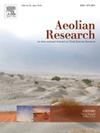Aeolian influences on gully erosion in clay-rich soils in a humid subtropical climate, Southeast USA
IF 3.4
3区 地球科学
Q2 GEOGRAPHY, PHYSICAL
引用次数: 0
Abstract
This study evaluates aeolian processes as significant but overlooked factors in runoff-driven gully erosion in humid subtropical climates. A network of 105 erosion pins installed in gully channels, interfluves, and sidewalls on an eroding hillslope in southern Appalachia was monitored weekly (2012–2018); concurrently, meteorological data were collected on site every 5 min. Wind variables were aggregated to weekly periods and statistical analyses (correlation, autocorrelation, Ordinary Least Squares (OLS) regression) were performed to (i) determine impacts of wind and wind-driven rain on gully erosion, (ii) assess seasonal gully erosion patterns relative to wind and wind-driven rain, and (iii) evaluate slope aspect effects on erosion of gully sidewalls. Annual OLS regression models for gully erosion using wind variables had low explanatory power (adjusted R2 = 0.067 (channels) to 0.197 (sidewalls)). The greatest gully erosion activity occurred in winter and spring aligning with periods of highest wind speeds; seasonal erosion and wind patterns were confirmed with autocorrelation. Seasonal OLS regression models had higher explanatory power (adjusted R2 = 0.044 to 0.367), with strongest models in autumn, suggesting seasonal importance of wind-related drivers for gully erosion. Southwesterly prevailing wind direction was normal to the gully axis, suggesting influence of slope aspect; higher erosion rates were recorded in the windward sidewalls but differences were statistically insignificant. Though rainfall and freeze–thaw activity are primary drivers of gully erosion in southern Appalachia, this analysis confirms that seasonal aeolian processes are significant contributors. These results may be used to improve standard predictive models of gully erosion in humid subtropical climates.
美国东南部湿润亚热带气候中富含粘土的土壤中风沙对沟壑侵蚀的影响
该研究评估了风成过程是湿润亚热带气候中径流驱动的沟道侵蚀的重要但被忽视的因素。在阿巴拉契亚南部一个受侵蚀的山坡上,每周监测105个侵蚀销钉网络,这些销钉安装在沟道、沟道和侧壁上(2012-2018);同时,每5分钟收集一次现场气象数据。将风变量汇总到每周周期,并进行统计分析(相关、自相关、普通最小二乘(OLS)回归),以确定风和风雨对沟槽侵蚀的影响,(ii)评估相对于风和风雨的季节性沟槽侵蚀模式,(iii)评估坡向对沟槽侧壁侵蚀的影响。使用风变量的沟道侵蚀年度OLS回归模型解释力较低(调整后的R2 = 0.067(通道)至0.197(侧壁))。冬季和春季沟蚀活动最大,与风速最高的时期一致;季节侵蚀和风型具有自相关关系。季节性OLS回归模型具有较高的解释能力(调整后的R2 = 0.044 ~ 0.367),其中秋季模型的解释能力最强,说明风相关驱动因素对沟壑区侵蚀的季节性重要性。西南盛行风向与沟轴正相关,受坡向影响;在迎风侧壁处记录到较高的侵蚀速率,但差异在统计上不显著。虽然降雨和冻融活动是阿巴拉契亚南部沟沟侵蚀的主要驱动因素,但这一分析证实,季节性风成过程是重要的贡献者。这些结果可用于改进湿润亚热带气候下沟壑侵蚀的标准预测模型。
本文章由计算机程序翻译,如有差异,请以英文原文为准。
求助全文
约1分钟内获得全文
求助全文
来源期刊

Aeolian Research
GEOGRAPHY, PHYSICAL-
CiteScore
7.10
自引率
6.10%
发文量
43
审稿时长
>12 weeks
期刊介绍:
The scope of Aeolian Research includes the following topics:
• Fundamental Aeolian processes, including sand and dust entrainment, transport and deposition of sediment
• Modeling and field studies of Aeolian processes
• Instrumentation/measurement in the field and lab
• Practical applications including environmental impacts and erosion control
• Aeolian landforms, geomorphology and paleoenvironments
• Dust-atmosphere/cloud interactions.
 求助内容:
求助内容: 应助结果提醒方式:
应助结果提醒方式:


